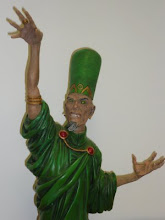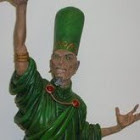 Hugely enjoyable and entertaining collection of stories featuring the pulp hero from the Hellboy universe, Lobster Johnson. The stories all capture the elements of the pulp stories and use them in interesting ways. They never feel like rehashes of old ideas, there is a committed energy and drive to the cast and the plots that make them stand on their own.
Hugely enjoyable and entertaining collection of stories featuring the pulp hero from the Hellboy universe, Lobster Johnson. The stories all capture the elements of the pulp stories and use them in interesting ways. They never feel like rehashes of old ideas, there is a committed energy and drive to the cast and the plots that make them stand on their own.Caput Mortuum, art by Tonci Zonjic opens the collection with a clear deceleration of intent that the rest of the stories follow through on. A couple of young men out for a little trouble get more than they expect when some melts on them. From there is is really a short distance to a airship and a suitably demented plot that also draws nicely on the pre-World War II American context. The art has tremendous force and drive, the action is fast and feels physical, the Lobster is the sharp and direct.
Satan Smells a Rat, art, colouring and letters by Kevin Nowlan is the most pulpy of the stories, a man fins a rotting corpse in his hotel room and more steal his car. He is pursued by Lobster Johnson and at the same time a mysterious man in a wheelchair is getting a treatment from a doctor. The neat tying up of the plot threads is a joy, the way that justice is served in the final panel is perfect. The art is clean and detailed, the cast are full of energy and the bright colours make the whole story lift off the page.
Tony Masso's Finest Hour , art by Joe Querio is a move into the supernatural that is always lurking in any Hellboy related story. It is also a very smart and sharp black joke about being very, very careful what you ask for. Getting it can prove to be a bit of a problem.
A Scent of Lotus, art by Sebastian Fiumara is the longest story in the collection and it makes the most extensive use of the context and the regular supporting cast. The USA was not involved in a war, there were a lot of others who were and they were small proxy struggles going on in the shadows in the USA. There is also a nice reminder of the very adversarial relationship that the Lobster has with the police, he is no tolerated vigilante, he is a target. The tightly wound plot plays out with great timing and juggles all the elements nicely. The art is tremendous, the need to have the utterly bizarre intrude into the concrete concerns of the time is handled with flair, the threat is both forceful and wonderfully off the wall.
The Prayer of Neferu, art by Wilfredo Torres is a very enjoyable bow to one of the enduring themes of the pulp stories in their hey day, the allure of Ancient Egypt and the mysteries of their numerous gods. A theft from a museum develops into something very considerably more sinister as the anticipated, illicit unwrapping of a mummy becomes a way to open a door to ancient power. This proves to be a very, entertainingly, bad idea. The clean art is just what the story needs to allow the cast be insane without every being stupid, and the living mummy is everything it should be.
Throughout all the stories it is extraordinary how Dave Stewart matches the tone and intent of the stories with his colouring, it gives the necessary extra push to the stories that need to be bright and bold as well as shadowy and mysterious to be successful. The lettering by Clem Robins is so natural that it is possible not to see the skill and craft. A great collection by a creative team who have taken care to honour the spirit of the originals and still be fresh and contemporary
.


No comments:
Post a Comment